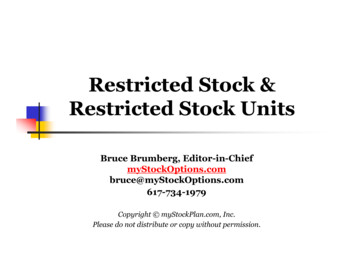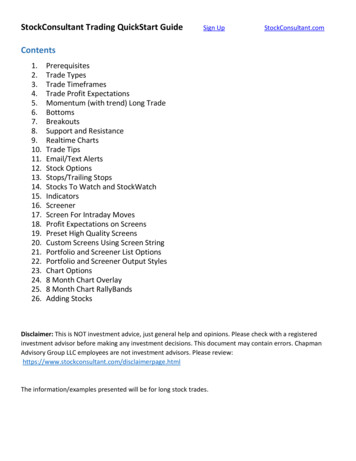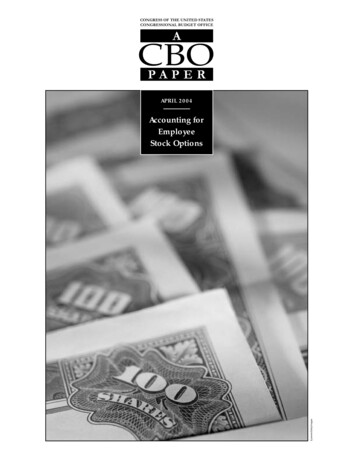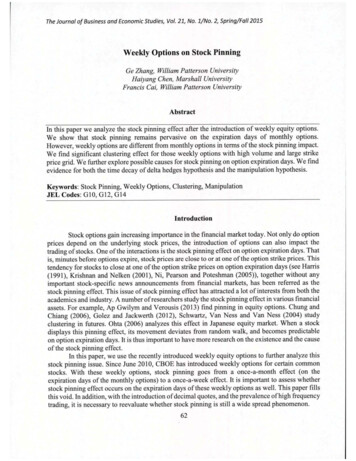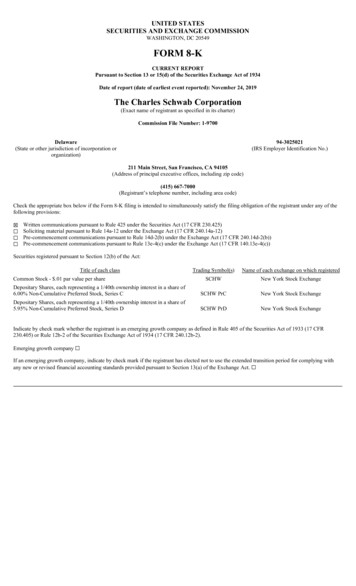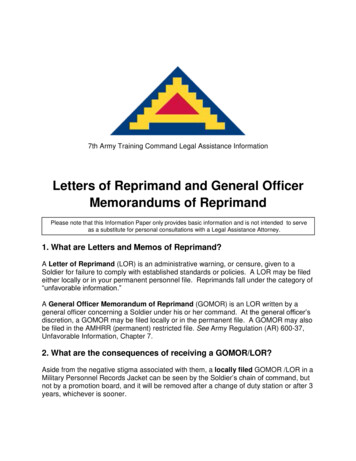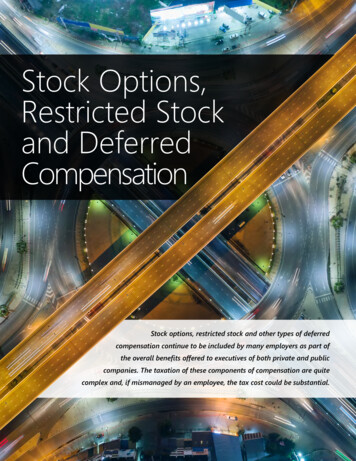
Transcription
Stock options, restricted stock and other types of deferredcompensation continue to be included by many employers as part ofthe overall benefits offered to executives of both private and publiccompanies. The taxation of these components of compensation are quitecomplex and, if mismanaged by an employee, the tax cost could be substantial.RETURN TO TOC51Stock Options, Restricted Stock and Deferred CompensationStock Options,Restricted Stockand DeferredCompensation
EisnerAmper 2020 Personal Tax Guide Stock Option PlansStock options may represent a significant portion ofan employee’s overall compensation. If you hold stockoptions, it is vital to understand the tax rules related toyour options in order to maximize the after-tax cashflow related to these instruments. It is recommended tofrequently review your inventory of options which havebeen granted but not yet exercised, along with stockstill held from previously exercised options, to developa strategy for exercising your options and selling yourstock while minimizing your tax exposure.There are two kinds of employee stock options:incentive stock options (“ISOs”) and nonqualifiedstock options (“NQSOs”). The tax rules governing thetaxation of the exercise of options and the subsequentsale of shares differ substantially between ISOs andNQSOs. For all employee stock options, there are threecritical dates to remember for tax purposes: (1) thedate the options are granted to you, (2) the date theyare exercised, and (3) the date the stock acquired viathe options is sold. You must carefully plan when toexercise stock options and how long to hold the shares(after they are exercised) before selling them. Incentive Stock OptionsISOs give you the right to purchase company stock inthe future at a fixed price that is determined at the timethe options are granted. The options usually must beexercised within ten years of receipt. The ISOs cannot betransferred (except on death) and can be exercised onlyduring employment or within three months of leavingthe company. The exercise price cannot be less than thestock’s fair market value (“FMV”) at the time of the grant,and thus the stock must appreciate before the ISOs haveany value. If they do — and once you’ve satisfied theapplicable holding periods — you can buy shares ata price that is below their fair market value.The key tax consequences related to the granting andexercising of ISOs include the following: T here is no tax liability on the date the options aregranted. T here is no regular tax liability when you exercise apreviously granted ISO. However, the spread betweenthe exercise price (what is paid for the shares) and thefair market value of the shares at the time of exercise istreated as an addition when computing your AMTI. I f the stock acquired by exercising the ISOs is owned atleast two years from the time the options were grantedor one year after they were exercised, whichever islater, a profitable sale of the stock will produce longterm capital gain income taxed at a maximum rate of20%, plus a 3.8% Medicare Contribution Tax on netinvestment income for taxpayers above the thresholdamounts. The gain will generally be the differencebetween the fair market value of the stock on the dateof the sale and your exercise price. This is known asa qualifying disposition. For AMT purposes, the basisin the stock will be the fair market value on the dateof exercise (to account for the adjustment mentionedabove). Thus, the capital gain will be lower for AMTpurposes than for regular tax purposes, although themaximum of a 20% federal tax rate applies to each. A disqualifying disposition occurs if you sell the stockwithin the later of one year after the option is exercised,or within 24 months of the grant date. The gain onthis sale will be included as compensation and will betaxed at a federal rate as high as 37%. If the price ofthe stock sold changed from the date of exercise, youmay also have a short-term gain component as well.However, there are no Social Security or Medicare taxesdue on the compensation derived from disqualifyingdispositions of ISOs.In order to make the best decision of when to exerciseyour options and sell the underlying shares from bothcash flow and tax perspectives, you need to: P roject both your regular tax and AMT for the currentyear to determine the number of shares you canexercise without incurring a current-year AMT liability. P roject multiple future tax scenarios based on differentRETURN TO TOC52
D etermine how much cash you have available toexercise the options and, if necessary, consider afinancing option for purchasing the stock. Amongthese alternatives are a cashless exercise and a stockswap. These techniques will be discussed later in thischapter. A MT CreditIf the exercise of ISOs results in an AMT liability, youwill be eligible in future years to receive an AMT creditfor AMT paid on these option exercises. Generally, thecredit you can use is limited to the annual amount thatyour regular tax exceeds your AMT without regardto the credit in each year. Any unused credit can becarried forward until the full amount is used. While itis usually recommended to avoid paying AMT on ISOexercises whenever possible, there may be situationswhen you may decide to go ahead with the exercisebecause of favorable market conditions.Please see the chapter on tax credits for a detaileddiscussion of the AMT credit. ISO ScenariosThe first decision to make is when to exercise yourexisting options, from now until before they are dueto expire. Once you have exercised the options, youthen must decide when to sell the shares. However,the tax consequence of selling the shares compared tocontinuing to hold the shares can be complicated sinceit depends on several factors. Some are clearly defined,such as the current trading price, the original exerciseprice, the trading price at the time of the exercise of theoption, and the length of time you have held the sharessince you exercised the option. But trying to plan fordifferent scenarios when it is impossible to predict thefuture price of the stock makes it difficult to know thebest choice. Here are some alternatives based on yourcurrent holdings combined with certain assumptions. S hould You Exercise Early?Exercising your options early rather than waiting untilthe expiration date can be advantageous, but you mustconsider cash flow and potential tax costs. On the plusside, exercising early: Starts your holding period so you can be eligible forthe federal long-term capital gain rate sooner. A llows you to manage your AMT liability by giving youthe ability to exercise just enough options to reacha break-even point between the AMT and regulartax (thereby avoiding the AMT). This can be doneannually to allow you to exercise your options withminimal, or no, AMT cost. M ay reduce your overall AMT liability if you are ableto exercise the ISOs at a time when you think themarket price is close to bottoming out. Since theprice is lower and the spread between the fair marketvalue and your exercise price may be negligible, youcan exercise more options without incurring an AMTliability, or just having to pay a small liability. Evenif the exercise triggers the AMT you’ll pay less thanyou would if you had exercised an equal number ofoptions at a time when the stock price was higher.Alternatively, on the negative side, exercising early: A ccelerates the use of funds you need to purchasethe shares, M ay create an AMT liability before you have theproceeds from the sale of the stock to pay an AMTliability, and E xposes you to a loss if the value of the shares dropsbelow your exercise cost.RETURN TO TOC53Stock Options, Restricted Stock and Deferred Compensationstock prices to assist you in deciding if you shouldexercise options now, even at the expense of incurringan AMT liability, to gain from potentially greater futuretax savings. Also, you should consider the availability ofthe AMT credit discussed below.
EisnerAmper 2020 Personal Tax GuideTax Tip8. ISO Tax BenefitsAssume the following facts:1. You are granted incentive stock options to buy 9,000 shares of your company stock for 20 per share on June 3, 2009.2. On January 10, 2018, you exercise all 9,000 options when the fair market value is 30.3. You hold the shares until January 12, 2019 and then sell them for 45 per share, and you were in the AMT in all years up to the yearof the sale.Your tax consequences without considering the Medicare Contribution Tax of 3.8% would be as follows: There is no tax due when the options are granted. There is no regular tax due when you exercise the grant and purchase the shares. However, you will have an AMT preference of 90,000 (9,000 shares at the excess of 30 over your cost of 20). Assuming you are already in the AMT, your additional AMT tax is 25,200 ( 90,000 times the AMT rate of 28%).When you sell the shares: You have a federal regular tax liability of 45,000 computed by applying the 20% long-term capital gain rate to the gain of 225,000,computed by subtracting the cost of 180,000 (9,000 shares at 20 per share) from your proceeds of 405,000 (9,000 shares at 45 pershare). You will be eligible to offset your regular tax from the sale by 25,200 of AMT that you paid when you exercised the option. This is yourAMT credit amount, but you can only utilize it to the extent your regular tax exceeds your AMT before the offsetting credit. Even if you cannot utilize the AMT credit because you are still in the AMT, your AMT tax on the gain is 27,000. This is 20% of theAMT gain of 135,000 based on proceeds of 405,000 less your AMT tax cost of 270,000 (9,000 shares at 30 per share when youexercised the options and reported a tax preference amount). You pay the lower AMT tax of 27,000 in the year of the sale rather thanthe regular tax of 45,000, thus saving 18,000 currently and possibly saving an additional 25,200 in the future. If you are not able to use all the AMT credit, you can continue to carry the unused credit forward to offset regular tax in a subsequentyear. ISO Exercised in Prior Yearswould be 13 per share ( 12 less the 25 value whenyou exercised the options). If you are in the AMT thisyear, your AMT loss on the sale would be 130,000 ( 13per share times 10,000 shares), creating a potential taxsavings of 27,140 in taxes ( 130,000 times the 20%long-term capital gain rate plus 30,000 times 3.8%Medicare Contribution Tax on net investment income).Assume the following: You have held 10,000 shares formore than 12 months from the exercise of an ISO grantin a prior year. Your exercise cost was 15 per share,and the stock was trading at 25 per share when youexercised the grant. You were subject to the AMT in theyear of the exercise on the full amount of the spreadbetween the fair market value of 25 and the exercisecost of 15.If the current trading price is higher than yourexercise price but lower than the trading priceat the time you exercised the grantAssume the stock is currently trading at 19 per share.If you are not in the AMT for the year, you will realizea gain of 4 per share ( 19 less exercise cost of 15),resulting in a tax of 9,520 (23.8% of 10,000 shares at 4 gain per share). But you may actually save taxessince you have an AMT credit available to offset yourregular tax, if not already utilized. The AMT credit isIf the current trading price is lower than yourexercise priceIf you have net capital gains for the year, you can sellthe shares and realize a capital loss. As an example,assume the stock is currently trading at 12 per share.While you would only have a 3 per share regular taxloss ( 12 less your exercise cost of 15), your AMT lossRETURN TO TOC54
If the current trading price is higher than bothyour exercise price and the trading price at thetime of the exerciseIf you sell the shares, you will have a capital gain forboth regular tax and AMT purposes. Assume thecurrent stock price is 35. If you are not in the AMT,you would pay tax on the gain of 20 per share ( 35less your exercise cost of 15). As discussed above, youmay have an AMT credit available to offset the tax onthe gain. If you are subject to the AMT this year, yourAMT gain would be 10 per share ( 35 less the priceat the time of exercise of 25). Your tax increase forfederal tax purposes would be based on the AMT gainof 10 rather than the regular tax gain of 20. However,the additional 3.8% Medicare Contribution Tax on netinvestment income would be based on the 20 gain. ISO Exercised Earlier in the Current YearIf you exercised ISOs earlier in the year, you may wantto consider selling shares in a disqualifying disposition ifcertain conditions exist. Again, let’s assume an originalexercise price of 15 per share and a trading price of 25 per share at the time of exercise.If the current trading price is less than the priceyou paid to exercise the optionFirst, determine if the AMT preference amount of 10per share ( 25 trading price at the time of exercise lessyour cost of 15 per share) will put you into the AMT orincrease an already existing AMT liability. If so, considerselling the stock to eliminate the AMT that you will haveto pay even though the stock price has dropped. As TaxTip 9 illustrates, you could end up with a substantial taxwithout any funds to pay the tax. Also, you can alwaysbuy back the stock as long as you wait 30 days to avoidthe wash sale rule discussed in the chapter on capitalgains and dividends. If the AMT preference amountdoes not put you into the AMT, you can choose tocontinue holding the shares if you believe the stockwill appreciate.Tax Tip9. Eliminate the AMT if the Stock Price DropsAfter an ExerciseA falling stock price can result in costly tax consequences if the sale of stock purchased through exercising an ISO is not planned forproperly. Take the facts in Tax Tip 8 but assume your exercise of 9,000 shares was earlier this year and the price per share has fallen backto 20, your exercise price. As Tax Tip 8 demonstrates, your AMT tax on the exercise would be 25,200 ( 90,000 preference at 28%) if theAMT applies. You will have to pay this tax even though the selling price of your shares is currently equal to the price you paid for them.What can you do? Sell the shares before the end of the year so that you will have a disqualifying disposition. You would not have a regular tax liability since the selling price of 20 is now equal to your exercise price. But you will eliminate the 25,200 AMT that you wouldpay if you did nothing.It may make sense to consider selling the shares even if the selling price is greater than your exercise price. Let’s say the stock price hasdropped to 23 per share after exercise and you will be in the AMT this year. If you sell the stock before the end of the year, you will realize ordinary income of 27,000 (9,000 shares at a gain of 3 per share based on the selling price of 23 and your cost of 20 per share).However, the AMT liability on the disqualifying disposition will be 7,560 ( 27,000 x AMT rate of 28%), which is less than the 25,200 AMTthat you would pay if you held the shares (as computed above). Because the wash sale rule (as discussed in the chapter on capital gains)does not apply to securities sold at a gain (regardless of any AMT benefit you receive), you can then repurchase the shares in the openmarket, even at a lower price, so that you would still own the same number of shares.RETURN TO TOC55Stock Options, Restricted Stock and Deferred Compensation 28,000 (28% of 10,000 shares at an AMT spread of 10per share). Your tax savings will be 18,480 ( 28,000AMT credit less the 9,520 regular and MedicareContribution tax on the sale, assuming you havesufficient regular tax liability).
EisnerAmper 2020 Personal Tax GuideTax Tip10. Use the AMT to Your Advantage to ReduceTaxes on the Sale of ISOsAssume you exercised an ISO grant in 2008 and purchased 30,000 shares at the exercise price of 5 per share when the stock was sellingfor 15 per share. Despite the tax preference amount of 300,000 (30,000 shares times the 10 per share spread) you did not have an AMTliability that year because you had substantial ordinary income. You sell the shares in 2019 for 40 per share and you are in the AMT.Long-term capital gainTax at 20%Effective tax rate on saleRegular taxAMT 1,050,000 750,000210,000150,00020%14.29%Note: This table does not include the impact of the Medicare Contribution Tax on net investment income.The long-term capital gain for regular tax purposes is 1,050,000 (proceeds of 1,200,000 less the 150,000 you paid to purchase theshares). For AMT purposes, the gain is only 750,000 since your basis is 15 per share (fair market value at the time of the exercise, eventhough you did not pay the AMT in that year). The result of the sale is that you only pay a current federal effective tax rate of 14.29%( 150,000 tax on the actual gain of 1,050,000).If the current trading price is higher than yourexercise price but lower than the trading pricewhen you exercised the optionIf you sell the shares, you will have a disqualifyingdisposition and the excess of the current tradingprice over your exercise price will be taxable ascompensation at ordinary income tax rates as highas 37%. But if you expect to be in the AMT this year,the sale of the shares will eliminate the AMT of 10per share on phantom appreciation that no longerexists. As an example, let’s assume the stock price hasdropped to 18 per share. If you sell the shares, you willhave ordinary income of 3 per share for both regulartax and AMT compared to 10 of income for AMTpurposes had you taken no action.If the current trading price is higher than bothyour exercise price and the trading price at thetime of the exerciseOnce again, if you sell the shares you will have adisqualifying disposition and the excess of the fairmarket value on the exercise date over your exerciseprice will be taxable as compensation at ordinaryincome tax rates. The additional increase on the sale atthe date of exercise will be taxed as a short-term capitalgain. So if the stock is selling for 30 per share, a saleof the shares would result in 15 of income per sharesold taxed at potentially 37% for regular tax purposes.In addition, 5 per share may be subject to theMedicare Contribution Tax of 3.8%. Thus, if you are notsubject to the AMT during the year, it would not makesense to sell the stock during the year. If you would havebeen in the AMT with or without the ISO preferenceitem it may make sense to sell the shares by year-end.This is because you may never get a benefit for theAMT paid. Nonqualified Stock OptionsUnlike ISOs, the exercise of NQSOs creates taxableordinary income in the year of exercise for both regulartax and AMT purposes. The income is equal to theexcess of the stock’s fair market value on the date ofRETURN TO TOC56
When you sell the stock after exercising, anyappreciation/depreciation in the stock’s value will betaxed as capital gains/losses. The holding period for theunderlying stock starts when you acquire the shares —it does not include the time you held the options. Forlong-term capital gain treatment, you must hold theshares for more than one year after the exercise date.Unlike ISOs, NQSOs are sometimes transferable.However the employee (and not the transferee) willgenerally recognize income for tax purposes upon theexercise of the options.You are not allowed to receive in-the-money optionswithout triggering substantial penalties under provisionsof the Internal Revenue Code restricting this type ofdeferred compensation (see below).Tax Tip 11 illustrates the tax consequences of an exerciseand sale of shares received from the exercise of anNQSO grant.Tax Tip11. NQSO Tax ConsequencesIf the 9,000 shares from exercise of the ISOs in Tax Tip 8 were from the exercise of NQSOs, you will recognize 90,000 of taxable compensation from the exercise (9,000 shares at 30 per share fair market value less the 20 exercise cost). When you sell the stock after holding it formore than one year, from the exercise of NQSOs you will have a long-term capital gain of 135,000 (9,000 shares at 45 less your basis of 30 per share) at a maximum federal tax cost of 27,000 ( 135,000 at 20%). Your net cash benefit from the exercise and sale will be:Proceeds from the sale 405,000(180,000)Cost to exercise the shares (9,000 shares at 20 per share)Tax on exercise of options ( 90,000 at 37%)(33,300)Tax when you sell the shares ( 135,000 at 20%)(27,000)Net cash benefit 164,700Note: This example does not take into consideration Social Security and Medicare taxes. Financing TechniquesUnless you have sufficient available cash, it can beproblematic to come up with the funds to exercise yourstock options. You can borrow money — sometimesfrom the company itself — but there are other ways tofinance your stock acquisition. Two such techniques area cashless exercise and a stock swap.A cashless exercise occurs when a broker lends you thecash needed to exercise the options and then, usuallyon the same day, helps you sell the stock. The brokerrecoups the funds you borrowed as well as a smallamount of interest and you keep the excess funds. Yourcost for the transaction is only the small interest charge.A stock swap occurs when you use previously acquiredcompany stock to pay for the options’ exercise cost.Some companies will even grant you more optionsRETURN TO TOC57Stock Options, Restricted Stock and Deferred Compensationexercise over the exercise price plus any amount thatwas paid for the option, where applicable. The grantingof an NQSO does not result in taxable income unlessthe value of the option is readily ascertainable, whichgenerally is not the case. The income recognized uponexercise will be taxed as compensation and will besubject to both Social Security and Medicare taxes.
EisnerAmper 2020 Personal Tax Guidecalled “reloads” if you exercise an option with a stockswap. The number of additional options granted willbe equal to the number of shares used to pay theexercise price. Restricted StockThe tax treatment of restricted stock differs considerablyfrom stock options. If you receive compensation in theform of stock subject to a substantial risk of forfeiture,you can defer the recognition of income until the stockis no longer subject to that risk or you sell the stock.But you can elect, under IRC Sec. 83(b), to recognizeordinary income when you receive the stock. Youmust make this election within 30 days after receivingthe stock. However, before making the election, makesure your company’s deferred compensation plan withrespect to compensation received in the form of stockis in compliance with the requirements discussed in thenext section.An IRC Sec. 83(b) election can be extremely importantif the income taxable to you on the grant date isnegligible. Why? Because the election allows you toconvert future stock appreciation from ordinary incomeinto long-term capital gain income, which is typicallytaxed at a preferential tax rate. If you do not make theelection, you will pay tax at ordinary income tax rates onthe appreciation when the restrictions lift regardless ofwhether or not you sell the stock and realize any gainon the sale. See Tax Tip 12.The disadvantage of making an IRC Sec. 83(b) electionis that you pay tax at ordinary income tax rates in thecurrent year. Plus, taxes paid as a result of the electioncan’t be refunded if you eventually forfeit the stock orthe stock’s value decreases. You will have a capital losswhen you sell the stock, but not if you forfeit it.Revenue Code which allows for certain employees toelect to defer income from stock options or restrictedstock units (“RSUs”). Under IRC Sec. 83(i), eligibleemployees of a private company that grants stockoptions or RSUs to at least 80% of full-time employeesmay elect to defer recognition of any such income untilthe earlier of (i) five years from the date of vesting of thestock option or RSUs or (ii) the date on which the stockbecomes freely transferrable to another party.In IRS Notice 2018-97, clarification was issued by the IRSon the new code IRC Sec. 83(i). The notice stated thefollowing: (a) To be qualified equity grants for IRC Sec.83(i), the company must issue equity grants to at least80% of employees in a calendar year; (b) companiescan specifically issue equity grants that don’t qualify forthis new code section; (c) the deferred shares at vestingor exercise must be escrowed, which the employeemust agree to at the time of this election.Employees ineligible for this new deferral are thefollowing: a 1% owner, CEO, CFO and relatedfamily members, as well as any of the four highestcompensated officers of the corporation for the taxyear or who were one of the four highest compensatedofficers of the corporation for any of the ten precedingtax years. Deferred Compensation PlansThe tax treatment of compensation received througha deferred compensation plan depends on rulesgoverning the initial election to defer compensationand the ability to take distributions. The initial electionto defer compensation must generally be made in thecalendar year prior to the year the income is earned.Distributions can only be made: Impact of the Tax Cuts and Jobs Act A t scheduled times selected at the time of the deferral,based on either specific dates or the age of theparticipant.Under the TCJA, IRC Sec. 83(i) was added to the Internal A t the termination of employment or service.RETURN TO TOC58
Additional Reporting Requirements T o alleviate an unforeseen emergency.Every corporation that transferred to an employee ashare of stock related to that person’s exercise of an ISOduring the current tax year is required to file Form 3921with the IRS for each transfer made. Form 3921 includesthe following information: F ollowing a change in the ownership or effectivecontrol of the employer.Failure to follow these rules will result in: T axation of the compensation ‘deferred’ at the time it isdeferred or credited to the participant, or at the time itvests, whichever is later. A n additional tax of 20% on top of the ordinaryincome tax on the amount treated as compensation. A n interest assessment based on the IRSunderpayment rate plus 1% on the tax liability resultingfrom the recognition of the compensation.Note: ISOs are excluded from these provisions becausetheir exercise price must be equal to their value at thetime of the grant. T he date the option was granted, T he date the employee exercised the option, T he number of shares of stock transferred to theemployee, T he fair market value of the stock when the option wasexercised, and T he exercise price of the stock.The forms are not required for an employee who is anon-resident alien. Employees must receive the Forms3921 by January 31 following the end of the calendaryear of reporting. The Form is also required to befiled with the IRS with the corresponding Form 1096by February 28 following the calendar year reported(March 31 if filing electronically).There are similar filing requirements for employee stockpurchase plans.RETURN TO TOC59Stock Options, Restricted Stock and Deferred Compensation O n the disability or death of the participant.
EisnerAmper 2020 Personal Tax GuideTax Tip12. The Benefit of an IRC Sec. 83(b) Electionfor Restricted StockYou receive 10,000 shares of restricted stock with a fair market value of 3 per share. In anticipation of an initial public offering (“IPO”), a tenfor-one stock split gives you 100,000 shares. At the time of the IPO, the stock is offered at 6 per share and the risk of forfeiture is removed.You sell the shares two years later in 2019 at 8 per share.If you make an IRC Sec. 83(b) election within 30 days after receiving the stock Y ou have 30,000 of compensation in the current year (10,000 shares at 3 per share) with a maximum federal tax cost of 11,100( 30,000 at 37% in 2019). Y our basis in the stock is 0.30 per share after the split ( 30,000 of realized compensation divided by 100,000 shares). Y our holding period begins on the day you receive the stock. Y ou realize a long-term capital gain of 770,000 (100,000 shares at 8 per share less your basis of 0.30 per share) when you sellthe stock, at a maximum federal tax cost of 154,000 ( 770,000 at 20%). Y ou incur a Medicare Contribution Tax on net investment income of 29,260 ( 770,000 at 3.8%). Y ou defer the tax you would have to pay when the company goes public to the time when the stock is sold.If you don’t make the election Y ou don’t have any compensation income this year. Y ou have compensation of 600,000 (100,000 shares at the IPO price of 6 per share) when the company goes public (andthe substantial risk of forfeiture no longer exists due to a change of control feature) at a maximum federal tax cost of 222,000( 600,000 at 37%). Y ou have a long-term capital gain of 200,000 when you sell the stock (100,000 shares at 8 per share less your basis of 6 pershare) at a maximum federal tax cost of 47,600 ( 200,000 at 23.8%).Income Tax ComparisonIf you don’t make the election 269,600If you make the election194,360Tax savings by making the election 75,240RETURN TO TOC60
exercise the options and, if necessary, consider a . financing option for purchasing the stock. Among these alternatives are a cashless exercise and a stock swap. These techniques will be discussed later in this chapter. editAMT Cr. If the exercise of ISOs results in an AMT liability, you . will be eligible in future years to receive an AMT .
